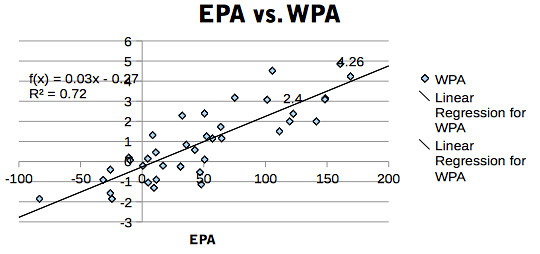I hate to join in the relentless QB analysis, since that’s all most people will be talking about this week, but with the number of articles saying Ben Roethlisberger “just wins” or talking about what could happen “If Ben wins his third Super Bowl”, I’d like to compare QBs using a stat that at least doesn’t depend on how the team performs when they aren’t on the field.
Whether “clutchness” actually exists in football is something to be debated (and a topic for the offseason!), but what is it? Most people would say it is the ability to come through in big situations, as opposed to making big plays down 42-7.
Fortunately, the folks at Advanced NFL Stats have numbers for both situations. Expected points added (EPA) measures the change in the drive situation after a play. If a play goes for ten yards on third-and-six, rest assured the expected points the team scores on that drive goes up. Win probability added (WPA) does the same thing, but factors in score differential and time remaining, giving a clearer picture of the game situation. Therefore, a “clutch player” is someone whose WPA is better, relatively speaking, than their EPA.
Analysis after the jump!
Here is a scatter plot of EPA vs. WPA for this season:

If EPA and WPA perfectly matched, the points on the graph would exactly match the line. They don’t, but the R2 value means that they 71% match, i.e. if you used just EPA to predict someone’s WPA, you’d be pretty close.
I put “AR” by Aaron Rodgers’ point on the graph and “BR” by Ben Roethlisberger’s point on the graph. Interestingly, it looks like Rodgers has been more “clutch” than Ben this year, though it doesn’t factor in rushing plays. Let’s go through both QBs using the equation up there:
Rodgers: 0.0251(168.6) – 0.2656 = 3.96 vs. actual WPA of 4.26
Roethlisberger: 0.0251(122.2) – 0.2656 = 2.80 vs. actual WPA of 2.40
So this year, Rodgers outperformed his predicted WPA by 0.3 while Roethlisberger underperformed his predicted WPA by 0.4, though both are fairly close to the line, so I wouldn’t necessarily call either one “clutch” based just on this chart.
I would go back a few years, but that will be my main method for analyzing whether clutchness exists in general, since clutch players will outperform their predicted WPA most of the time. Instead, I’ll look at some of the outliers from this year’s chart.
The QB who most outperformed their predicted WPA in 2010 was Matt Ryan of the Falcons, who had a WPA of 4.54 versus the 2.37 that you would expect from his EPA. On the other end, with a WPA of -1.11 versus an expected WPA of 0.93? Carson Palmer. Hmm, maybe there is something to this clutchness thing after all!



















